Introduction
Rice (Oryza sativa L.) is the second most important cereal crop after wheat based on global consumption and utilization. As such, the crop is becoming increasingly essential for food security in a number of low-income, food deficit countries in sub-Saharan Africa (SSA).1 For example, rice production in West Africa rose from 2.4 million metric tons in 1994 to 3.1 million metric tons in 2002.2
In spite of the economic importance of the crop, there is decline in grain yield due to reduced length of fallow with increased human population, weed pressure and low soil fertility.3 According to4 reported that in SSA, fertilizer is recommended for solving low soil fertility but high application rates combined with erratic rainfall leads to loss of essential nutrients through surface runoff.5 Nevertheless, fertilizer application is a vital component of integrated weed management and nitrogen fertilizer plays a crucial role in the competitive balance between weeds and rice6; 7,6 reported crop competitiveness might improve with improved nutrient status, although some weeds are more efficient in utilizing available nutrients. Reports of8,9 indicated that, weeds are capable of assimilating nutrients faster and in relatively higher amounts than cultivated crops. Consequently, in the presence of weed pressure, fertilizer application might enhance weed growth over crop growth. Hence, management of crop fertilization and timing of weed control are promising agronomic practices to reduce weed-crop interference.10 Studies by11 showed that judicious and proper use of N and P fertilizers could markedly increase grain yield and improve rice quality. However, these responses might depend on rice cultivar, soil type, the growing season and water management.11 emphasised that integrated use of organic manure and chemical fertilizers are beneficial for sustainable crop production. However, subsistence farmers find it difficult to produce large quantities of organic manure required to support optimum crop production.13
Rice production in West Africa primarily depends on rainfall and is associated with high weed interference as major biological constraint.14,15 reported that, in China, about 10 million tons of rice is lost annually due to weed competition and such quantity of rice is sufficient to feed 56 million people for one year. As such, weeds constitute major pest to upland rice production by competing with the crop for nutrients, water, and light and secretes toxic roots exudates that could suppress growth and development of rice16,17 noted weed infestation as second to drought stress in limiting yield and quality of upland rice, with weed management as a key element in upland rice production. In a survey of upland rice ecology, covering 80% of the total production area in Nigeria, weeds constituted the most widely reported biological limitation to the industry.18 Untimely management of weeds could lead to 28 – 100% yield loss.18 Rice therefore requires good weed management practices to enhance its ability to withstand weed interference to maximise grain yield.19 Small scale rice farmers practice hand weeding twice at 3 and 6 weeks after planting (WAP); but for lack of labour, one hand weeding is common in northern Ghana.16 First-hand information of the superior performance of NERICA 1 to cope with weeds and soil amendment for optimum yield production is still awaited. The objectives of the study were to determine the combined effect of soil amendment and weeding regime, examine whether the variety could tolerate one weeding regime as done by some farmers and inspect the synergy between organic and inorganic soil amendments on yield components and grain yield of NERICA 1.
Materials and Methods
Site Description
The research was conducted at the experimental field of the Faculty of Agriculture, University for Development Studies at Nyankpala in the Tolon district of Northern region, Ghana during the 2010 cropping seasons. The mean annual rainfall distribution of the study site is about 1100mm with daily temperatures ranging from 24˚C to 38.8˚C with the minimum and maximum relative humidities of 52% and 85%, respectively.20
Experimental Design and Materials Used
The study was a 4 x 6 factorial experiment which consisted of four levels of fertilizer and six weeding regimes totalling 24 treatments in the present study. The trial was laid in randomized complete block design with 4 replications. Each plot measured 3 m x 4 m with 2 m and 1 m between replications and plots respectively. NERICA 1 rice variety was planted and bunds were created to avoid spill over of runoff water between experimental units.
Factor A: Four levels of Organic manure plus inorganic fertilizers
1. Zero organic manure and inorganic fertilizer (control). 2. Recommended rate of organic manure (5 t/ha cow dung), 3. Half recommended rate organic manure + half-recommended fertilizer (2.5 t/ha cow dung + 30-30-15 kg/ha NPK) and 4. Recommended rate of inorganic fertilizer (60-60-30 kg/ha),
Factor B: Six levels of weeding regimes (W)
W1: Weedy check, W2: Weed-free check, W3: Weeding at 3 weeks after planting (WAP), W4: Weeding at 4 WAP, W5: Weeding at 5 WAP and W6: Weeding at 3 and 6 WAP.
Crop Management
Ploughing and harrowing of the experimental field was carried out in early July across the slope to prevent erosion. Planting was done in middle of July in both years. Five seeds were sown per hill at a spacing of 20 cm x 20 cm. Cow dung was applied using broadcasting method and later incorporated into the soil 2 WAP. Basal application was conducted at 3 WAP using NPK fertilizer and the top dressing at 6 WAP using ammonia. The weedy check plots were not weeded throughout the cropping season, whilst weed-free plots were given season-long hoe weeding at two weeks interval after planting.
Data Collection
Five plants were randomly selected and tagged per plot to monitor plant height at 3 weeks interval till harvest. Weed species cover score was sampled with 1 m2 quadrat at three throws per plot and the summed dominance ratio (SDR) determined as:

Where f = frequency of weed species occurrence and d = density of occurrence, on the scale; 0 = plant species not seen, 1= 1 plant of a specific species/quadrat, 2 = 2-5 plants of a specific species/quadrat; 3= 6-19 plants of a specific species/quadrat, and 4 = ≥ 20 plants of a specific species/quadrat.
Five plants were tagged and used for leaf area index (LAI) determination at 42 days after planting (DAP). Length and width of the first, middle and last leaves were measured and their averages were computed as:
LAI = L*W*N*0.72/A Eqn. 2
Where L= length of leaf, W= width of leaf, N= number of leaves per plant, A= area covered per plant and 0.72 = constant for the determination of LAI of rice.21
Visual observation was made to monitor number of days to 50% flowering of plant stand per plot. Vegetative tillers at 50 DAP and reproductive tillers (at maturity) were determined using 1 m2 quadrat with three throws per plot. Fresh weed samples per 1 m2 quadrat for three throws per plot were harvested and fresh weight taken and oven dried at 80˚C for 48 hours and re-weighed for biomass. Straw weight was taken at harvest from net plot area, sun dried and weighted.The grain yield per net plot was measured after sun drying and threshing. Grain yield for each treatment was compared with weed free plots to determine effect of weed interference on grain yield of NERICA 1 as weed index (WI):

Statistical Analysis
The data collected were subjected to statistical analysis using GenStat statistical package (11th Edition) for analysis of variance. The least significant difference at 5% level of probability was used to separate treatment means. Correlation coefficient was used to determine the relationship between grain yield and number of yield components. Weed Index was used to determine best treatment for weed control.
Results and Discussions
Rainfall
High rainfall with good distribution characterized the 2010 cropping season, with the month of August recording the highest, above 250 mm (Fig. 1). [22] reported that NERICA rice responds well to low rainfall, with a weekly minimum of 20 mm being adequate to support grain yield.
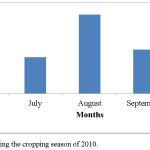 |
Figure 1: Amount of rainfall during the cropping season of 2010. Click here to View figure |
Effect of soil amendment and weeding regime on plant height
Soil amendment combined with weeding regime significantly influenced (P < 0.05) most of the traits measured except for plant height at (3, 6, 9 and 12 WAP). Soil amendment with full rate of NPK fertilizer (60-60-30 kg/ha) produced the tallest plants followed by half manure + half NPK (2.5 t/ha + 30-30-15 kg/ha) (Fig. 2). This could be due to the adequate availability of nutrients, which promoted physiological development of the crop.
At 6, 9 and 12 WAP, weeding at 3 and 6 WAP exhibited increased plant height similar to weed free; but similar result was obtained with weeding once at 3 WAP (Fig. 3). This could probably be due to the early elimination of weeds which might have resulted in less competition during the cropping season with consequential increased availability of nutrients to the plants.
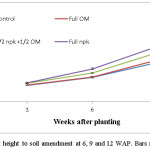 |
Figure 2: The response of plant height to soil amendment at 6, 9 and 12 WAP. Bars represent S.E.D. Click here to View figure |
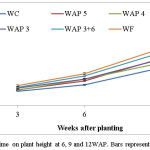 |
Figure 3: Effect of weeding regime on plant height at 6, 9 and 12WAP. Bars represent S.E.D. Click here to View figure |
Weed flora
The weed flora was dominated by annuals, mostly broadleaves followed by grasses and sedges. The flora consisted of 55.10% broadleaves, 24.49% grasses, 12% shrubs and 6.12% sedges (Table 1). The most dominant species were; Panicum maximum, Commelina diffusa, Setaria barbata, Andropogon gayanus, Oldenlandia herbaccea, Ageratium conyziodes, Ludwigia decurrens, Cyperus esculentus, Dactyloctenium aegytium and Digitaria gayana. It is well reported that the most aggressive and yield limiting weed flora are the grasses and segdes (Akobundu, 1987 and Dzomeku et al., 2007).
Table 1: Occurrence of weed species at experimental units during the 2010 cropping season.
| Weed species | Control | Full Organic Manure | ½Manure+½NPK | Full NPK | Life Span |
| a. Broadleaves |
SDR (%) |
||||
| Acanthospernum hispitum DC. | 1.43 | 0.72 | 0.00 | 0.00 | A |
| Ageratium conyziodes Linn. | 5.92 | 1.92 | 1.83 | 3.62 | A |
| Amaranthus spinosus Linn. | 0.00 | 0.00 | 0.00 | 1.49 | A |
| Aspilia africana Pers. | 0.00 | 0.00 | 2.97 | 0.00 | P |
| Cleome viscora L. | 0.00 | 2.16 | 0.69 | 1.28 | A |
| Commelina benghalensis L. | 3.77 | 4.81 | 1.83 | 2.34 | A/P |
| Commelina diffusa Burm.f. | 6.41 | 5.77 | 3.67 | 4.05 | P |
| Conyza sumatrensis Retz Walker. | 0.94 | 0.96 | 1.38 | 1.49 | A |
| Euphorbia hirta Linn. | 0.00 | 0.00 | 0.00 | 1.71 | A |
| Hyptis spicigera Lam. | 0.94 | 1.68 | 0.00 | 1.28 | A |
| Hyptis suaveolens Poit. | 1.43 | 0.72 | 0.69 | 0.64 | A |
| Laportea aestuans Linn. Chew. | 0.00 | 1.92 | 0.00 | 0.00 | A |
| Laportea ovalifolia Schum. Chew. | 0.94 | 0.72 | 0.69 | 1.49 | A/P |
| Melochia corchorifolia Linn. | 0.94 | 0.00 | 0.00 | 0.00 | P |
| Mitracarpus villosus Sw. DC. | 3.51 | 4.81 | 2.28 | 1.07 | A |
| Oldenlandia corymbosa Linn. | – | – | – | 1.92 | A |
| Oldenlandia herbaccea Linn. Roxb. | 6.79 | 3.85 | 7.1 | 6.18 | A |
| Phyllanthus amarus Schum & Thonn. | 2.15 | 0.72 | 5.04 | 5.76 | A |
| Pteridium aquilinum Linn. Kuhn. | 0.00 | 0.72 | 0.00 | 0.00 | A |
| Schwenkia americana L. | 0.94 | 1.92 | 0.92 | 1.92 | A |
| Senna obtusifolia L. | 0.94 | 1.44 | 2.52 | 1.28 | P |
| Sesanum alatum Thonning. | 0.00 | 0.00 | 0.69 | 1.28 | A |
| Sesanum indicum Linn. | 0.00 | 0 | 0.00 | 1.92 | A |
| Synedrella nodiflora Gaertn. | 2.34 | 2.4 | 6.62 | 0.64 | A |
| Tridax procumbens Linn. | 0.00 | 3.37 | 0.00 | 0.00 | A |
| Vernonia cinera Linn. | 0.00 | 0.00 | 0.00 | 0.85 | A |
| Waltheria indica Linn. | 0.00 | 0.00 | 0.00 | 1.28 | P |
| b. Grasses | |||||
| Andropogon gayanus Kunth. | 6.79 | 9.62 | 4.34 | 6.39 | P |
| Axonopus compressus Sw. P. Beauv. | 0.00 | 0.72 | 0.00 | 0.00 | P |
| Brachiaria lata Schumach. | 4.26 | 1.44 | 0.69 | 3.2 | P |
| Cynodon dactylon Linn. Pers. | 0.00 | 0.00 | 4.11 | 0.00 | P |
| Dactyloctenium aegytium Linn. P. Beauv. | 4.68 | 1.68 | 1.83 | 1.49 | A/P |
| Digitaria gayana Kunth. | 2.79 | 2.16 | 4.57 | 4.48 | P |
| Digitaria horizontalis Willd. | 5.69 | 3.13 | 4.35 | 2.35 | A |
| Panicum maximum Jacq. | 11.69 | 11.78 | 11.42 | 10.23 | P |
| Paspalum scrobiculatum Linn. | 6.15 | 7.21 | 3.21 | 4.26 | A |
| Pennisetum pecidellatum Trin. | 0.00 | 0.00 | 0.69 | 0.00 | A |
| Rottboellia conchinchinensis Lour. Clayton. | 0.00 | 0.00 | 4.35 | 3.41 | A |
| Setaria barbata Lam. Kunth. | 4.71 | 6.25 | 5.05 | 5.33 | A |
| c. Sedges | |||||
| Cyperus esculentus Linn. | 4.22 | 7.69 | 2.06 | 1.71 | P |
| Cyperus rotundus Linn. | 0.00 | 0.00 | 4.34 | 2.77 | P |
| Mariscus alternifolius Vahl. | 0.00 | 1.68 | 0.00 | 0.00 | P |
| d. Shrubs | |||||
| Combretum hispidum Laws. | 2.34 | 0.00 | 3.20 | 1.49 | A |
| Icacina trichantha Oliv. | 1.89 | 0.96 | 1.60 | 0.00 | A |
| Ipomoea involucrata P. Beauv. | 0.72 | 0.00 | 1.38 | 0.85 | P |
| Ludwigia decurrens Walt. | 2.79 | 2.4 | 2.06 | 1.49 | A |
| Sida acuta Burm.f. | 0.00 | 0.00 | 0.00 | 4.26 | P |
| Stachytarpheta cayennensis L.C.Rich. Schau. | 1.89 | 2.64 | 1.83 | 2.77 | P |
† A= Annual weeds, P = Perennial weeds, A/P = Annual and Perennial weeds.
Effect of soil amendment and weeding regime on leaf area index
Full rate of NPK enhanced LAI (P < 0.001), followed by half doses of manure (cow dung) and NPK fertilizer (Fig. 4). Weeding at 3 and 6 WAP recorded the highest LAI, followed by weeding once at 3, 4 or 5 WAP whilst weedy check reduced LAI (Fig. 5). The high values of leaf area index recorded for full dose of NPK could be attributed to adequate nutrient availability which might have enhanced chlorophyll concentration in the leaves for accumulation of photosynthates. Less weed-crop competition could have also occurred under weeding regimes of twice and one weeding than the weedy-check, affording the crop higher productivity.
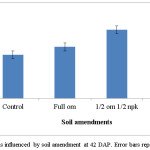 |
Figure 4: Leaf Area Index as influenced by soil amendment at 42 DAP. Error bars represent S.E.D. Click here to View figure |
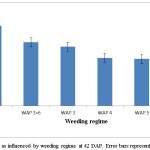 |
Figure 5: Leaf Area Index as influenced by weeding regime at 42 DAP. Error bars represent S.E.D. Click here to View figure |
Tiller count
Soil amendment significantly increased tillering (P < 0.001) at 50 DAP, maximised by both full rate of NPK and half NPK plus half ogarnic manure application (Fig. 6). Similarly, weeding regime varied tillering (P < 0.001) with weeding at 3 and 6WAP notably equalling weed free (Fig.7).
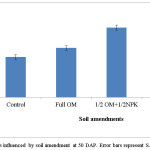 |
Figure 6: Tiller count as influenced by soil amendment at 50 DAP. Error bars represent S.E.D. Click here to View figure |
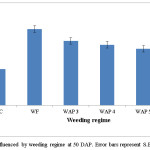 |
Figure 7: Tiller count as influenced by weeding regime at 50 DAP. Error bars represent S.E.D. Click here to View figure |
Effective tiller count
Half doses of organic manure and NPK supported (P < 0.001) increased productive tillering, similar to full NPK application with 200 effective tillers/m2 (Fig. 8) whilst weeding at 3 and 6 WAP was at par with weed free regime with about 210 effective tillers/m2 (Fig. 9). These results stress the need for augmenting soil fertility and at least twice weeding for NERICA rice to avoid weed competition for optimum growth and production. The trend of results was consistent with the earlier report of [23] who noted nitrogen fertilizer application increased yield of NERICA rice through increase tillering.24 also reported that improved soil fertility could positively impact on grain yield through enhanced tillering. Timely weed removal from rice could reduce weed competition and allelopathic effects as earlier reported.14,16,25
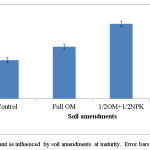 |
Figure 8: Effective tiller count as influenced by soil amendments at maturity. Error bars represent S.E.D. Click here to View figure |
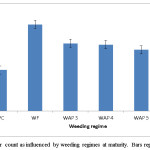 |
Figure 9: Effective tiller count as influenced by weeding regimes at maturity. Bars represent S.E.D. Click here to View figure |
Days to 50% flowering
The main effects of soil amendment and weeding regimes influenced flowering of NERICA 1 (P < 0.001), such that half doses of organic manure and NPK fertilizer entries flowered earlier than the control (Fig. 10). Weeding twice at 3+6 WAP and once at 5WAP flowerest earliest as the free entry (Fig. 11). Earliness in flowering could be assigned to presence of the ideal soil nutrient environment devoid of weed interference, whilst delayed flowering was expected in low fertility plots since N stress could delay flowing of the crop.
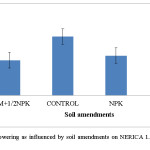 |
Figure 10: Days to 50% flowering as influenced by soil amendments on NERICA 1. Error bars represent S.E.D. Click here to View figure |
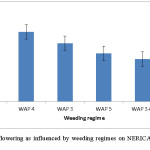 |
Figure 11: Days to 50% flowering as influenced by weeding regimes on NERICA 1. Error bars represent S.E.D. Click here to View figure |
Rice straw biomass
Soil amendment and weeding regime varied straw biomass significantly (P < 0.001) with maximum biomass attained with full dose of NPK followed by half doses of NPK and organic manure (Fig. 12). Notably twice weeding only reduced the parameter by 20% relative to the weed-free control (Fig. 13), making the farmer hand weeding an adequate practice to promote rice production where labour is available.
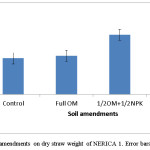 |
Figure 12: Effect of soil amendments on dry straw weight of NERICA 1. Error bars represent S.E.D. Click here to View figure |
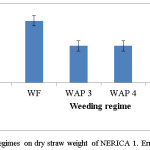 |
Figure 13: Effect of weeding regimes on dry straw weight of NERICA 1. Error bars represent S.E.D. Click here to View figure |
Weed biomass
Weed biomass was determined by weeding regime (P < 0.001) with twice weeding at 3 and 6WAP and once at 3WAP and 4 WAP supporting reduced biomass but higher than the weed-free control (Fig. 14).
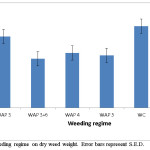 |
Figure 14: Impact of weeding regime on dry weed weight. Error bars represent S.E.D. Click here to View figure |
Weed index
Minimum weed index (WI) was noted for full NPK application combined with weeding at 3 and 6 WAP (Fig. 15). Arguably, integration of soil fertility with twice weeding gave the lowest range of WI followed by once weeding at 3WAP and application of soil amendment. It is apparent that where farmers weed only once, early weeding at 3WAP could be most effective for weed management if either organic or inorganic soil amendments are applied.
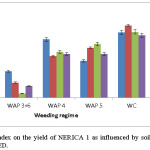 |
Figure 15: Effect of weed index on the yield of NERICA 1 as influenced by soil amendment and weeding regime. Bars represent SED. Click here to View figure |
Grain yield
Grain yield of NERICA 1 was significantly enhanced (P = 0.002) such that combination of full rate of NPK and twice weeding at 3 and 6 WAP gave highest grain yield similar to the weed free plus full NPK, being 3000kg/ha (Fig. 16). It was envisaged that the best treatments afforded the rice crop adequate amount of nutrients and reduced weed interference. The result is in consonance with the findings of26,27 who reported higher grain yield from relatively weed-free condition.
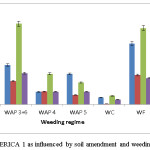 |
Figure 16: Grain yield of NERICA 1 as influenced by soil amendment and weeding regime. Click here to View figure |
1000 Seed weight
Rate of fertilizer application by weeding regime significantly (P < 0.05) determined 1000 seed weight of NERICA 1 with weedy check in combination with soil amendment drastically reducing the parameter below 25g (Fig. 17). The results could be due to high weed competition for growth factors such as nutrients, water, light, space and carbon dioxide, and allelopathic influence of the weeds on rice, as reported by.14
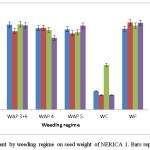 |
Figure 17: Soil amendment by weeding regime on seed weight of NERICA 1. Bars represent SED. Click here to View figure |
Table 2: Correlation matrix of significant parameters during experiment
| Parameters | Height WAP 9 | Height WAP12 | LAI (cm2) | Tillering-(no/m2) |
Straw biomass (kg/ha) |
Seed weight(g) | Grain yield(kg/ha) |
| Height WAP 9 | 1 | ||||||
| Height WAP 12 | 0.807** | 1 | |||||
| LAI(cm2) | 0.769** | 0.703** | 1 | ||||
| Tillering (no/m2) | 0.733** | 0.646** | 0.717** | 1 | |||
| Straw biomass (kg/ha) | 0.699** | 0.715** | 0.68** | 0.736** | 1 | ||
| Seed 1000(g) | 0.47* | 0.462* | 0.321 | 0.486** | 0.605** | 1 | |
| Grain yield (kg/ha) | 0.736** | 0.691** | 0.714** | 0.681** | 0.787** | 0.423* | 1 |
*,**significant at (P<0.05%) and (P<0.001) level of probability respectively
Correlation and regression analysis
Correlation
Significant positive correlation occurred between grain weight with plant height at 9 WAP and 12 WAP, leaf area index, effective tiller count, straw weight and 1000 grain weight (Table 2). The traits measured could be considered as reliable yield contributing parameters with, for example, effective tiller count accounted for 68.1% of grain yield.
Conclusion and recommendation
Soil fertility and weed management are paramount issues that require research solution to enhance crop productivity in the Guinea savannah uplands. The objectives of the study were to determine the combined effect of soil amendment and weeding regime, examine whether the variety could tolerate one weeding regime as done by some farmers and inspect the synergy between organic and inorganic soil amendments on yield components and grain yield of NERICA 1. Overall results indicate full dose NPK (60-60-30 kg/ha) in combination with twice hand weeding at 3 and 6WAP was required for optimum growth and yield of NERICA 1. Notably, grain yield of NERICA 1 was significantly enhanced by combination of full rate of NPK and twice weeding at 3 and 6 WAP giving 3000kg/ha. Full NPK application combined with weeding at 3 and 6 WAP also minimized weed index. Apparently, weeding once at 3WAP combined with either full dose of NPK or organic manure gave acceptable weed index. Tillering at 50 DAP and productive tillering were maximised by both full rate of NPK and half NPK plus half organic manure applications with 250 tillers/m2 respectively 200 productive tillers/m2. Full rate of NPK maximised LAI and straw biomass followed by half doses of manure and NPK fertilizer. Results showed the synergy of inorganic and organic manure on rice production could be exploited by farmers with access to organic manure and NPK. The weed flora was dominated by annuals, mostly broadleaves followed by grasses and sedges.
References
- Rodenburg, J., Saito, K., Kakaï, R.G., Touré, A., Mariko, M. and Kiepe, P. Weed competitiveness of the lowland rice varieties of NERICA in the southern Guinea Savanna. Field Crops Research, 114(3), pp.411–418 (2009).
CrossRef - Kamara, A.Y., Ekeleme, F, Omoigui, L.O. and Chikoye, D. Influence of nitrogen fertilization on yield and yield components of rain-fed lowland NERICA ® rice in the northern Guinea savanna of Nigeria. , 6(13), pp.3092–3097 (2011).
- Saito, K., Azoma, K. and Oikeh, S.O. Soil & Tillage Research Combined effects of Stylosanthes guianensis fallow and tillage management on upland rice yield , weeds and soils in southern Benin. Soil & Tillage Research, 107(2), pp.57–63 (2010).
CrossRef - McIntire, J. and Powell, J. African Semi-Arid Agriculture Cannot Produce Sustainable Growth without External Inputs. In: Powell, J., Fernandez-Rivera, Williams, T., Renard, C. (Eds.). 1995.
- Rosen, C. J. and Horgan, B.P. “Preventing Pollution Problems from Lawn and Garden Fertilizer”, Extention.umn.edu. 2009.
- Raun, W.R. and Johnson, G.V. Improving nitrogen use efficiency for cereal production. Agron. J. 1999;9:357–363.
CrossRef - Camara, K.M., Payne, W.A. and Rasmussen, P.E. Long-term effects of tillage, nitrogen and rainfall on winter maize yields in the Pacific Northwest. Agron J. 2003;95:828–835.
CrossRef - Ali, S., Iqwal, A. and Zia, M.A. Weed-crop competition in wheat by nitrogen levels and herbicide doses. Pak. J. Biological Sci. 2003;6:452–455.
CrossRef - Blackshaw, R.E., Molnar, L.J. and Larney, F.J. Fertilizer, manure and compost effects on weed growth and competition with winter wheat in western Canada. Crop Protect. 2005;24:971–980.
CrossRef - Cathcart, R.J., Chandler, K. and Swanton, C.J. Fertilizer N rate and the response of weeds to herbicide. Weed Sci. 2004;52:291–296.
CrossRef - Kwarteng, J.A. and Towler, M.J. West Africa Agriculture. Macmillan press Ltd. 1994;108-109.
- Khan, A.R., Sarkar, S., Nanda, P. and Chandra, D. Organic manuring through Gliricidia maculate for Rice Production. International Centre for Theoretical Physiscs (UNESCO and IAEA), Trieste, Italy. International Report. IC/IR/200/10:1-4. 2001.
- Jama, B., Palm, C.A., bruvesh, R.J., Naing, J., Gachengo, C., Nziguheba, G. and Amedalo, B. Tithonia diversifolia as a green manure for soil fertility improvement in Western Kenya. Review Agroforestry System 49:201-222pp (2000).
- Akobundu, I.O. Weed Science in the Tropics; Principles and Practices. John Wiley and Sons, New York, USA. 1987;522.
- Zhang Ze pu. Weed management in rice in China. Summary presented at FAO workshop on Echinochloa spp. Control, Beijing, China, 27 May, 2000. 2001.
- Dzomeku, I.K., Agawu, E.T. and Dogbe, W. Responses of NERICA rice varieties to weed interference in the Guinea savanna uplands. Journals of Agronomy. 2007;6:262-269.
- De-Datta, S.K. Chemical weed control in tropical rice in Asia. Pans. 1972;18:433–440.
CrossRef - Johnson, D.E. Weed management in small holder rice production in the tropics. Natural Resources Institute. University of Greenwich Ghatham, Kent, UK. 1996:11.
- Moody, K. Weed Management in Rice. In: Weed Management for Developing countries. Labbrada, R., Caseley, J. C. and Parker, C (Eds), pp. 249-256. FAO Plant Production and Protection Paper 120. Rome. 1994.
- Savanna Agricultural Research Institute (SARI) (2008). Annual Report. 2008;221:
- Watson D.J. (2008). The physiological basis of variation in yield. Advances in Agronomy. 2008;4:101-145.
CrossRef - Africa Rice Center (WARDA)/FAO/SAA. NERICA: the New Rice for Africa – a Compendium. Somado EA, Guei RG and Keya SO (eds.). Cotonou, Benin: Africa Rice Center (WARDA); Rome, Italy: FAO; Tokyo, Japan: Sasakawa Africa Association. 2008;210.
- De Batista, J.J. Rice management and fertilization in the Entere Rios Province. Field Crops Res. 2002;16:40-47.
- Patra, D.D., Anwar, M. and Sukhusal, C. Integrated nutrient management and waste recycle for restoring soil fertility and productive in Japanese mint and mustard sequence in Utta Pradesh, India. Agriculture Ecosystem Environment. 2000;80:267-275.
- Atera, E.A., Onyango, J. C., Azuma, T., Asanuma, S. and Itoh, K. Field evaluation of selected NERICA rice cultivars in Western Kenya. African Journal of Agricultural Research. 2011;6(1):60–66.
- Moynul, M.D.H., Hossain, M.D.M., Rezaul, M.D., Khalequzzaman, H.R. ans Karim, S.M,R. Effect of varieties of rice and weeding on weed growth and yield of transplant among rice. Asian J. Plant Sci. 2003;2:993–998.
CrossRef - Mitra, B.K., Karim, A.J.M.S., Haque, M.M., Ahmed, G.J.U. and Bari, M.N. Effect of weed management practices on transplanted Aman rice. Agron. J. 2005;4:238–241.
CrossRef

